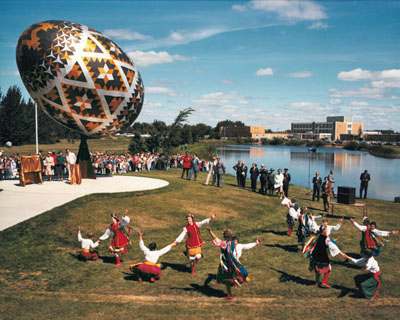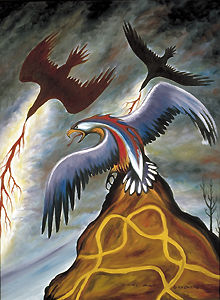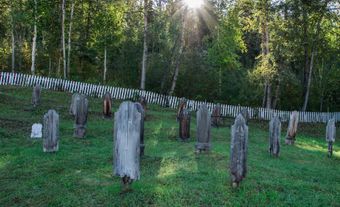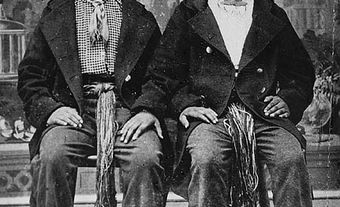Folklore was first introduced as a term in England in 1846 and today refers to information, wisdom and human expression that is passed on, usually anonymously, from generation to generation or transmitted and circulated as traditional cultural behaviour. Folkloric materials can be found anywhere and in any form, although past scholarship has favoured verbal folklore or oral literature: folk songs, folktales, epic, myth, legend, folk drama, riddles, proverbs, sayings and a variety of verses. Nonverbal folklore includes material culture such as folk architecture, folk art and crafts, dance, music, custom, ritual and belief, traditional folkways and amusements.

To become folklore, a song, story, custom or belief must go through a process of "folklorization" and meet the criteria and approval of the receiving community. During this filtering process, the item may undergo one or more revisions before it definitely enters into the community's cultural heritage.
Along with general recognition and appreciation, anonymity and variation are also features that characterize the folkloric process; thus, jokes come in many versions, folk songs in many variations and Easter eggs with different designs. Folk life is another general term that is sometimes used interchangeably with folklore, popular culture and folk tradition, although each has its own history and bias.
Roots of Folklore
The main purposes of folklore are to instruct, support, entertain and express communal and individual artistic taste and creativity. Modern scholarship has shown that folklore is an important aspect of all cultures because it helps people to comprehend and cope with their social and natural environment. The myths of Canada's Indigenous peoples exemplify how large bodies of folklore in many parts of the world depend on nature (e.g., the seasons and the cycle of life itself) to provide a meaningful framework for their folkloric traditions.
The urge to see and experience something out of the ordinary partly accounts for the periodic revival of interest in ethnic folklore and folk traditions, as illustrated by the popularity of Toronto's "Caravan," Winnipeg's "Folklorama," Edmonton's "Heritage Festival" and similar events. New interest in folklore focuses on sensory, nonlingual phenomena: the taste and smell of unusual foods, the moving colour and visual excitement of the ethnic folk dance, the detail of folk art and handiwork, and the unique acoustic appeal of folk song and folk music.
These manifestations of folklore thrive in modern settings, as shown by the popular annual Winnipeg Folk Festival. Sophisticated marketing techniques produce a highly compressed showcase of talent, ranging from contemporary folksingers to demonstrations of traditional weaving.
The trained folklorist sees a continuity from the winged deities of classical mythology to North America's "Superman." Folklore is able to bridge old and new by selecting and reinterpreting elements from the past in order to meet present needs.

Canadian Folklore
Geography and a diverse linguistic and ethnocultural composition prohibit a concise description of Canadian folklore. Most books structure folklore in chronological fashion, with 4 main bodies of lore reflecting the traditions of Canada's main population groups: Indigenous, French Canadian, Anglo-Canadian (English, Irish, Scottish, Welsh) and other ethnic groups.
Various factors favoured the preservation and development of folklore throughout the country: the prevalence of a rural population (at least until after WWII), a high percentage of illiteracy among certain groups in earlier times, and the use of folklore to foster local and national self-consciousness. French Canada, for instance, enjoyed a "golden age" of oral literature lasting into the 20th century. This was largely a result of French colonial policy, which did not allow the establishment of a press in New France, and later of the policies of English authorities, who consistently used English to introduce that language and Protestantism.
The lack of publication in French and the scarcity of French schools helped to maintain a culture rooted in folklore. Early French Canadian writers incorporated many traditional customs and legends into their works and fostered the recognition and admiration of the folk heritage.
French Canada's rich contact with the native population and Anglo-Canada's predilection for life by and on the sea helped to differentiate further the bodies of lore from one another. Since the 19th century the intermittent waves of immigrants and refugees from all parts of the world have greatly expanded the bounds of Canadian folklore by introducing new elements.
Canadian folklore has always been influenced by the US as well as other countries, and vice versa (e.g., the impact of the Canadian wilderness and the Mountie hero on the imagination of Americans). Elsewhere abroad, the exodus of native sons and daughters to Canada, and their early experiences as immigrants in this country, have stimulated the production of entire cycles of songs and stories about immigrating to Canada, cycles which in turn enter into the folklore of the original countries.
Travel notes and reports of 17th-century explorers, traders and missionaries are the earliest records of Canadian folklore. The first conscious efforts at recording and publishing folklore appear in the 19th century in French Canada. The search for a national identity and the corresponding reaction against foreign influences in Canadian life and letters provoked, after the Second World War, a renewed interest in the national past and popular tradition.
Folklore recordings and publications in folklore, partly in its genuine form, partly reshaped, began to appear in increasing numbers. The initiation of 2 especially important serial publications, Les Archives de folklore (published by Laval U since 1946) and the Mercury Series (published by the Canadian Centre for Folk Culture Studies at the Canadian Museum of History in Ottawa since 1972), enriched scholarly research. Centennial celebrations in 1967 stimulated further interest in folklore and emphasized the attractiveness of the nation's folklore heritage.
As the country became more urbanized, transitional forms emerged. Television and other mass-communication media have played an important role in this process, although their impact on Canadian folklore has not yet been fully researched or fully evaluated. All categories and types of folklore appear in Canada, but their distribution varies from culture to culture. Efforts to identify this lore properly and to assess and characterize the nature of distribution are frustrated by the lack of suitable, comparative data. The particularly rich and multiform development of folklore among Canada's native peoples is largely explained by the delayed impact of European influence.
This situation has long attracted the attention of scholars and enthusiasts whose collections and studies of native lore tended to focus on spoken narrative and ritual activities. The sun dance and ceremonies associated with the medicine man (Shaman) and native healing practices (e.g., the shaking tent ritual) are among the best documented.
The myths of Indigenous peoples are unique and significant aspects of Canada's folklore. These often tell about the theft of light and fire, and feature a culture hero who secures various things for his people. Such creation and hero myths include the raven and Thunderbird cycles of the West Coast and the Nanabozo stories of the Algonquian, which form two of the most extensive bodies of Indigenous myth. Sacred legends, incorporating elements from tribal history, and to a lesser extent fables and wonder tales, are important parts of both Indigenous folklore (see Religion and Spirituality of Indigenous Peoples in Canada).

Sung and spoken narrative is the major focus in French Canadian folklore, which includes, in addition to that of Québec, the folklore of Acadian communities in the Maritimes and of French communities in northern Ontario and parts of western Canada. The impact of Roman Catholicism is especially pronounced in many religious legends about the saints of the Middle Ages, miraculous healings and rescues, the creation and the flood.
This body of folktale also features international tales of magic, many of which have been traced to pre-Christian sources. Their plots illustrate the features of typical wonder tales: repetition by threes, an emphasis on trials and quests, the triumph of the youngest son, magic objects and supernatural helpers, marvellous transformations and happy endings.
In addition to an active inventory of jokes, anecdotes and circular formula tales, the traditional narrative folklore also includes many local legends reflecting lifestyles associated with such traditional occupations as farming, hunting, fishing and lumbering. Common subjects include hidden treasures, will-o'-the-wisps, flying canoes, werewolves, sorcerers and encounters with the devil.
Prominent personages in the French Canadian narrative tradition are the popular hero-figure Ti-Jean (Little John), a fabulous hunter named Dalbec, and Jean Cadieux, a voyageur whose tragic death is the subject of the earliest, distinctly French Canadian folk song (see Oral Literature in French). Anglo-Canadian folklore has not attracted attention equal to that given Indigenous and French Canadian folklore. This has resulted in comparatively few study materials, although much folkloric data can be culled from local histories and related sources (see Oral Literature).
Many varieties of folk songs have been well documented, especially those that pertain to children, lumbermen and seamen, including an important category of shipwreck songs from the East Coast and the Great Lakes. Few examples of international tales of magic have been found among Anglo-Canadians, although jokes and anecdotes are widespread and include popular tall tales and ethnic jokes, of which the "Newfie" jokes are especially common. There are some collections of superstitions and supernatural tales, mainly from Nova Scotia.
An active dept of folklore at Memorial University of Newfoundland in St John's provides the best documentation of Anglo-Canadian folklore. Especially important are mumming, riddles and other forms of folklore that are traced, recorded and studied in Newfoundland, although poorly documented elsewhere in Canada. Square-dance calls, children's autograph verses and legends about the Sasquatch, Ogopogo and related monsters of Western Canada are also collected.
The material folk culture of Anglo-Canadians attracted much interest as a consequence of the 1967 Centennial celebrations. A profusion of attractive coffee-table picture books and albums appeared, devoted to the documentation of Canadian houses, barns, log houses, fences, churches, lighthouses, outhouses, and furniture, pottery, quilts and hooked rugs.
The reports of the activities of English poltergeists on Canadian soil show the continued influence of "Old Country" folklore. The large number of popular urban tales, in the form of migratory belief legends transmitted by teenagers and bearing such motifs as "Baby-sitter mistakes child for turkey," "Girlfriend's legs cut off" and "The grandfather's liver," reveals the strong impact on Anglo-Canadian folklore of new folkloric patterns from the US.
Canada's folklore composite in the second half of the 20th century has its roots in over 70 different traditions from around the world (see Multiculturalism). Preliminary studies show, for example, the existence of a considerable body of folk beliefs and practices associated with folk medicine of the Pennsylvania Germans of southern Ontario; a sizable and varied body of lore among Ukrainians on the Prairies; and Old World narrative patterns among Icelanders in Manitoba and Yiddish-speaking Jews of Montréal.
In addition to these groups, folklore studies relating to other ethnic communities in Canada have also appeared among Canadians of Polish, Norwegian, Korean, Danish, Hungarian, Swedish, Italian, Greek, Chinese, Romanian and Finnish backgrounds, as well as Black Canadians, Doukhobors, Gypsies. In the 1960s, ethnic folk festivals became an especially productive phenomenon from coast to coast and attracted attention to Canada's rich heritage of folk traditions.

Folklore Studies
Undergraduate and graduate degree programs in folklore are offered in French (since 1944) at Laval in Québec City and in English (since 1962) at Memorial in St John's, Nfld. Instrumental in organizing and heading these programs in early years were Luc Lacourcière at Laval and Herbert Halpert at Memorial. Both Laval's Archives de folklore and Memorial's MUNFLA (Memorial U of Newfoundland Folklore and Language Archive) have amassed archival materials relating to the folklore of their respective provinces.
Other universities offering courses in Canadian folklore include Moncton, Québec at Trois-Rivières, York, Laurentian, Winnipeg, Manitoba, Saskatchewan, Calgary and Alberta. The dept of folklore at Laurentian U in Sudbury, founded by Germain Lemieux, has an extensive collection of Franco-Ontario folklore materials, and the Centre for the Documentation of Traditional Culture at Trois-Rivières, founded in 1970 by Robert-Lionel Séguin and Maurice Carrier, is important for its photographic and documentary archival materials relating to Québec material culture.
The country's leading folklore-research centre is the Canadian Centre for Folk Culture Studies, a unit of the Canadian Museum of Civilization in Ottawa. The centre is important for its holdings relating to French Canada, West Coast and Huron nations and the country's minority ethnic groups. The Manitoba Museum of Man and Nature in Winnipeg has a program exploring the ethnic character of the nonindigenous people of Manitoba, and its collections reflect the ethnic identities of these people.
The Folk Life program of the Provincial Museum of Alberta was created in 1975 and is responsible for the acquisition, documentation, research and interpretation of material on the cultural life of Alberta's nonindigenous people; its artifact collection contains more than 3000 pieces.
In 1964 the Canadian Folk Arts Council was established under government sponsorship and, with its network of affiliated councils, serves as the rallying point for the nation's numerous amateur and semiamateur folk performing groups. The council maintains its head offices in Toronto and Montréal and publishes a quarterly magazine, Troubadour. Other national organizations are the Canadian Folk Music Society (established 1957) and the Folklore Studies Assn of Canada (established 1975).
The major pioneering figure in Canadian folklore research in the 20th century is Charles Marius Barbeau, many of whose publications appeared under the auspices of the Canadian Museum. However, no distinctly Canadian approach has been developed for the study of folklore, and almost all major folklorists in Canada have received much of their formal academic training abroad.

By 1980 the country's 3 major folklore study centres had unofficially assumed separate but occasionally overlapping responsibilities for French Canadian folklore (Laval), Anglo-Canadian folklore (Memorial) and minority-language ethnic groups (Ottawa).
The most important bibliography in Canadian folklore is the joint compilation of Edith Edith Fowke and Carole Henderson Carpenter, A Bibliography of Canadian Folklore in English (1981). General works include Carpenter's monograph, Many Voices: A Study of Folklore Activities in Canada and Their Role in Canadian Culture (1979); K.S. Goldstein's Canadian Folklore Perspectives (1978); the only autobiography written by a prominent folklorist, Helen Creighton's A Life in Folklore (1975); Magnus Einarsson's multicultural photo-study, Everyman's Heritage: An Album of Canadian Folk Life (National Museums, 1978); and Edith Fowke's pioneering anthology, Folklore of Canada (1976).
In 1972 the journal Ethnomusicology (vol 16, no 2), edited by Israel J. Katz, devoted a special issue to Canada. Regional collections include Folklore of Nova Scotia by Mary L. Fraser, Folklore from Nova Scotia by Arthur Huff Fauset, Folklore of Lunenburg County, Nova Scotia by Helen Creighton, Christmas Mumming in Newfoundland edited by H. Halpert and G.M. Story, and Folklore of Waterloo County, Ontario by W.J. Wintemberg.
Among the varied publications on French Canadian folklore, the series Les Archives de folklore is internationally significant, as are the many works of C. Marius Barbeau.
Books by Leonard Bloomfield on the Cree, by Franz Boas on Northwest Coast Indigenous Peoples and by Barbeau on the Huron and West Coast Indigenous Peoples hold special interest in folklore studies of Canada's native peoples. Other researchers include Marie-Françoise Guédon, Diamond Jenness, Gertrude P. Kurath and Paul Radin. The special issue of Canadian Ethnic Studies 7 (1975, ed Robert B. Klymasz) on Ethnic Folklore in Canada is particularly valuable for folklore of ethnic groups.
The Canadian Museum of Civilization's Canadian Centre for Folk Culture Studies in Ottawa has also released a number of relevant reports in its Mercury Series of publications. In addition to Les Archives de folklore and Troubadour, 4 other folklore periodicals have been active since the 1970s: Bulletin of the Folklore Studies Association of Canada (est 1976), Canadian Folk Music Journal (est 1973), Canadian Folklore Canadien (est 1979) and Culture and Tradition (Memorial and Laval, est 1976).
The field of children's lore in Canada has attracted the attention of such researchers as Barbara Cass-Beggs, Edith Fowke and Kay Stone. Notable publications include a compilation by Peter B. Michalyshyn, Tic-Tac-Togetherness: A Collection of Intercultural Games for Children (1979). Study kits and exhibits prepared by several museums across the country alert developers of educational curricula to the richness of Canada's folk heritage. Oracle, a bulletin published by the Canadian Museum of Civilization, is also useful for teachers.

Nonprint materials relating to Canadian folklore include several works produced by or available through the National Film Board. Folk arts and crafts are well represented by 3 films, Maud Lewis, In Praise of Hands and Inventors of Thingumajigs. Three other films, Pen-Hi Grad, Wedding Day and Pleasure Faire, provide an insight into folk festivals, celebrations and rituals. Folk religion is well documented in the NFB film The Hutterites (see Hutterites), and in another film about the Doukhobors and their Living Book.
The Sunny Munchy Crunchy Natural Food Shop shows, in humorous fashion, the impact of traditional recipes and ingredients on modern eating habits. The Songs of Chris Cobb documents folk singing in a Newfoundland outport, and Hinchinbrook Diary and Bekevar Jubilee depict the general folklore complex of a particular community. Canadians Can Dance reveals the array of current Canadian folk-dance styles and traditions.
Of the many sound recordings produced over the years, the following are of special importance: Canadian Folk Songs (ed C. Marius Barbeau and released as vol 8 in the Columbia World Library of Folk and Primitive Music); over 20 titles on the Folkways label; and Canadian Folk Songs: A Centennial Collection, 9 records featuring innovative performers (RCA Victor, 1967).

 Share on Facebook
Share on Facebook Share on X
Share on X Share by Email
Share by Email Share on Google Classroom
Share on Google Classroom


